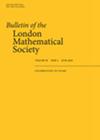求助PDF
{"title":"无量纲傅里叶限制不等式","authors":"Diogo Oliveira e Silva, Błażej Wróbel","doi":"10.1112/blms.70098","DOIUrl":null,"url":null,"abstract":"<p>Let <span></span><math>\n <semantics>\n <mrow>\n <msub>\n <mi>R</mi>\n <msup>\n <mi>S</mi>\n <mrow>\n <mi>d</mi>\n <mo>−</mo>\n <mn>1</mn>\n </mrow>\n </msup>\n </msub>\n <mrow>\n <mo>(</mo>\n <mi>p</mi>\n <mo>→</mo>\n <mi>q</mi>\n <mo>)</mo>\n </mrow>\n </mrow>\n <annotation>${{\\bf R}_{\\mathbb {S}^{d-1}}}(p\\rightarrow q)$</annotation>\n </semantics></math> denote the best constant for the <span></span><math>\n <semantics>\n <mrow>\n <msup>\n <mi>L</mi>\n <mi>p</mi>\n </msup>\n <mrow>\n <mo>(</mo>\n <msup>\n <mi>R</mi>\n <mi>d</mi>\n </msup>\n <mo>)</mo>\n </mrow>\n <mo>→</mo>\n <msup>\n <mi>L</mi>\n <mi>q</mi>\n </msup>\n <mrow>\n <mo>(</mo>\n <msup>\n <mi>S</mi>\n <mrow>\n <mi>d</mi>\n <mo>−</mo>\n <mn>1</mn>\n </mrow>\n </msup>\n <mo>)</mo>\n </mrow>\n </mrow>\n <annotation>$L^p(\\mathbb {R}^d)\\rightarrow L^q(\\mathbb {S}^{d-1})$</annotation>\n </semantics></math> Fourier restriction inequality to the unit sphere <span></span><math>\n <semantics>\n <msup>\n <mi>S</mi>\n <mrow>\n <mi>d</mi>\n <mo>−</mo>\n <mn>1</mn>\n </mrow>\n </msup>\n <annotation>$\\mathbb {S}^{d-1}$</annotation>\n </semantics></math>, and let <span></span><math>\n <semantics>\n <mrow>\n <msub>\n <mi>R</mi>\n <msup>\n <mi>S</mi>\n <mrow>\n <mi>d</mi>\n <mo>−</mo>\n <mn>1</mn>\n </mrow>\n </msup>\n </msub>\n <mrow>\n <mo>(</mo>\n <mi>p</mi>\n <mo>→</mo>\n <mi>q</mi>\n <mo>;</mo>\n <mi>r</mi>\n <mi>a</mi>\n <mi>d</mi>\n <mo>)</mo>\n </mrow>\n </mrow>\n <annotation>${\\bf R}_{\\mathbb {S}^{d-1}} (p\\rightarrow q;\\textup {rad})$</annotation>\n </semantics></math> denote the corresponding constant for radial functions. We investigate the asymptotic behavior of the operator norms <span></span><math>\n <semantics>\n <mrow>\n <msub>\n <mi>R</mi>\n <msup>\n <mi>S</mi>\n <mrow>\n <mi>d</mi>\n <mo>−</mo>\n <mn>1</mn>\n </mrow>\n </msup>\n </msub>\n <mrow>\n <mo>(</mo>\n <mi>p</mi>\n <mo>→</mo>\n <mi>q</mi>\n <mo>)</mo>\n </mrow>\n </mrow>\n <annotation>${{\\bf R}_{\\mathbb {S}^{d-1}}}(p\\rightarrow q)$</annotation>\n </semantics></math> and <span></span><math>\n <semantics>\n <mrow>\n <msub>\n <mi>R</mi>\n <msup>\n <mi>S</mi>\n <mrow>\n <mi>d</mi>\n <mo>−</mo>\n <mn>1</mn>\n </mrow>\n </msup>\n </msub>\n <mrow>\n <mo>(</mo>\n <mi>p</mi>\n <mo>→</mo>\n <mi>q</mi>\n <mo>;</mo>\n <mi>r</mi>\n <mi>a</mi>\n <mi>d</mi>\n <mo>)</mo>\n </mrow>\n </mrow>\n <annotation>${\\bf R}_{\\mathbb {S}^{d-1}} (p\\rightarrow q;\\textup {rad})$</annotation>\n </semantics></math> as the dimension <span></span><math>\n <semantics>\n <mi>d</mi>\n <annotation>$d$</annotation>\n </semantics></math> tends to infinity. We further establish a dimension-free endpoint Stein–Tomas inequality for radial functions, together with the corresponding estimate for general functions which we prove with an <span></span><math>\n <semantics>\n <mrow>\n <mi>O</mi>\n <mo>(</mo>\n <msup>\n <mi>d</mi>\n <mrow>\n <mn>1</mn>\n <mo>/</mo>\n <mn>2</mn>\n </mrow>\n </msup>\n <mo>)</mo>\n </mrow>\n <annotation>$O(d^{1/2})$</annotation>\n </semantics></math> dependence. Our methods rely on a uniform two-sided refinement of Stempak's asymptotic <span></span><math>\n <semantics>\n <msup>\n <mi>L</mi>\n <mi>p</mi>\n </msup>\n <annotation>$L^p$</annotation>\n </semantics></math> estimate of Bessel functions.</p>","PeriodicalId":55298,"journal":{"name":"Bulletin of the London Mathematical Society","volume":"57 8","pages":"2336-2353"},"PeriodicalIF":0.9000,"publicationDate":"2025-05-19","publicationTypes":"Journal Article","fieldsOfStudy":null,"isOpenAccess":false,"openAccessPdf":"","citationCount":"0","resultStr":"{\"title\":\"Dimension-free Fourier restriction inequalities\",\"authors\":\"Diogo Oliveira e Silva, Błażej Wróbel\",\"doi\":\"10.1112/blms.70098\",\"DOIUrl\":null,\"url\":null,\"abstract\":\"<p>Let <span></span><math>\\n <semantics>\\n <mrow>\\n <msub>\\n <mi>R</mi>\\n <msup>\\n <mi>S</mi>\\n <mrow>\\n <mi>d</mi>\\n <mo>−</mo>\\n <mn>1</mn>\\n </mrow>\\n </msup>\\n </msub>\\n <mrow>\\n <mo>(</mo>\\n <mi>p</mi>\\n <mo>→</mo>\\n <mi>q</mi>\\n <mo>)</mo>\\n </mrow>\\n </mrow>\\n <annotation>${{\\\\bf R}_{\\\\mathbb {S}^{d-1}}}(p\\\\rightarrow q)$</annotation>\\n </semantics></math> denote the best constant for the <span></span><math>\\n <semantics>\\n <mrow>\\n <msup>\\n <mi>L</mi>\\n <mi>p</mi>\\n </msup>\\n <mrow>\\n <mo>(</mo>\\n <msup>\\n <mi>R</mi>\\n <mi>d</mi>\\n </msup>\\n <mo>)</mo>\\n </mrow>\\n <mo>→</mo>\\n <msup>\\n <mi>L</mi>\\n <mi>q</mi>\\n </msup>\\n <mrow>\\n <mo>(</mo>\\n <msup>\\n <mi>S</mi>\\n <mrow>\\n <mi>d</mi>\\n <mo>−</mo>\\n <mn>1</mn>\\n </mrow>\\n </msup>\\n <mo>)</mo>\\n </mrow>\\n </mrow>\\n <annotation>$L^p(\\\\mathbb {R}^d)\\\\rightarrow L^q(\\\\mathbb {S}^{d-1})$</annotation>\\n </semantics></math> Fourier restriction inequality to the unit sphere <span></span><math>\\n <semantics>\\n <msup>\\n <mi>S</mi>\\n <mrow>\\n <mi>d</mi>\\n <mo>−</mo>\\n <mn>1</mn>\\n </mrow>\\n </msup>\\n <annotation>$\\\\mathbb {S}^{d-1}$</annotation>\\n </semantics></math>, and let <span></span><math>\\n <semantics>\\n <mrow>\\n <msub>\\n <mi>R</mi>\\n <msup>\\n <mi>S</mi>\\n <mrow>\\n <mi>d</mi>\\n <mo>−</mo>\\n <mn>1</mn>\\n </mrow>\\n </msup>\\n </msub>\\n <mrow>\\n <mo>(</mo>\\n <mi>p</mi>\\n <mo>→</mo>\\n <mi>q</mi>\\n <mo>;</mo>\\n <mi>r</mi>\\n <mi>a</mi>\\n <mi>d</mi>\\n <mo>)</mo>\\n </mrow>\\n </mrow>\\n <annotation>${\\\\bf R}_{\\\\mathbb {S}^{d-1}} (p\\\\rightarrow q;\\\\textup {rad})$</annotation>\\n </semantics></math> denote the corresponding constant for radial functions. We investigate the asymptotic behavior of the operator norms <span></span><math>\\n <semantics>\\n <mrow>\\n <msub>\\n <mi>R</mi>\\n <msup>\\n <mi>S</mi>\\n <mrow>\\n <mi>d</mi>\\n <mo>−</mo>\\n <mn>1</mn>\\n </mrow>\\n </msup>\\n </msub>\\n <mrow>\\n <mo>(</mo>\\n <mi>p</mi>\\n <mo>→</mo>\\n <mi>q</mi>\\n <mo>)</mo>\\n </mrow>\\n </mrow>\\n <annotation>${{\\\\bf R}_{\\\\mathbb {S}^{d-1}}}(p\\\\rightarrow q)$</annotation>\\n </semantics></math> and <span></span><math>\\n <semantics>\\n <mrow>\\n <msub>\\n <mi>R</mi>\\n <msup>\\n <mi>S</mi>\\n <mrow>\\n <mi>d</mi>\\n <mo>−</mo>\\n <mn>1</mn>\\n </mrow>\\n </msup>\\n </msub>\\n <mrow>\\n <mo>(</mo>\\n <mi>p</mi>\\n <mo>→</mo>\\n <mi>q</mi>\\n <mo>;</mo>\\n <mi>r</mi>\\n <mi>a</mi>\\n <mi>d</mi>\\n <mo>)</mo>\\n </mrow>\\n </mrow>\\n <annotation>${\\\\bf R}_{\\\\mathbb {S}^{d-1}} (p\\\\rightarrow q;\\\\textup {rad})$</annotation>\\n </semantics></math> as the dimension <span></span><math>\\n <semantics>\\n <mi>d</mi>\\n <annotation>$d$</annotation>\\n </semantics></math> tends to infinity. We further establish a dimension-free endpoint Stein–Tomas inequality for radial functions, together with the corresponding estimate for general functions which we prove with an <span></span><math>\\n <semantics>\\n <mrow>\\n <mi>O</mi>\\n <mo>(</mo>\\n <msup>\\n <mi>d</mi>\\n <mrow>\\n <mn>1</mn>\\n <mo>/</mo>\\n <mn>2</mn>\\n </mrow>\\n </msup>\\n <mo>)</mo>\\n </mrow>\\n <annotation>$O(d^{1/2})$</annotation>\\n </semantics></math> dependence. Our methods rely on a uniform two-sided refinement of Stempak's asymptotic <span></span><math>\\n <semantics>\\n <msup>\\n <mi>L</mi>\\n <mi>p</mi>\\n </msup>\\n <annotation>$L^p$</annotation>\\n </semantics></math> estimate of Bessel functions.</p>\",\"PeriodicalId\":55298,\"journal\":{\"name\":\"Bulletin of the London Mathematical Society\",\"volume\":\"57 8\",\"pages\":\"2336-2353\"},\"PeriodicalIF\":0.9000,\"publicationDate\":\"2025-05-19\",\"publicationTypes\":\"Journal Article\",\"fieldsOfStudy\":null,\"isOpenAccess\":false,\"openAccessPdf\":\"\",\"citationCount\":\"0\",\"resultStr\":null,\"platform\":\"Semanticscholar\",\"paperid\":null,\"PeriodicalName\":\"Bulletin of the London Mathematical Society\",\"FirstCategoryId\":\"100\",\"ListUrlMain\":\"https://londmathsoc.onlinelibrary.wiley.com/doi/10.1112/blms.70098\",\"RegionNum\":3,\"RegionCategory\":\"数学\",\"ArticlePicture\":[],\"TitleCN\":null,\"AbstractTextCN\":null,\"PMCID\":null,\"EPubDate\":\"\",\"PubModel\":\"\",\"JCR\":\"Q2\",\"JCRName\":\"MATHEMATICS\",\"Score\":null,\"Total\":0}","platform":"Semanticscholar","paperid":null,"PeriodicalName":"Bulletin of the London Mathematical Society","FirstCategoryId":"100","ListUrlMain":"https://londmathsoc.onlinelibrary.wiley.com/doi/10.1112/blms.70098","RegionNum":3,"RegionCategory":"数学","ArticlePicture":[],"TitleCN":null,"AbstractTextCN":null,"PMCID":null,"EPubDate":"","PubModel":"","JCR":"Q2","JCRName":"MATHEMATICS","Score":null,"Total":0}
引用次数: 0
引用
批量引用




 求助内容:
求助内容: 应助结果提醒方式:
应助结果提醒方式:


